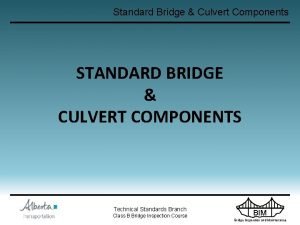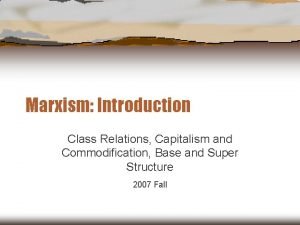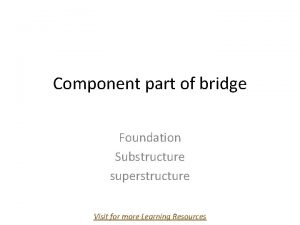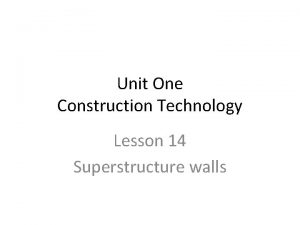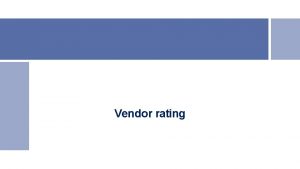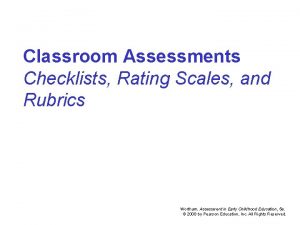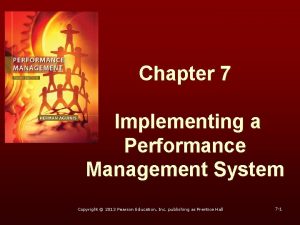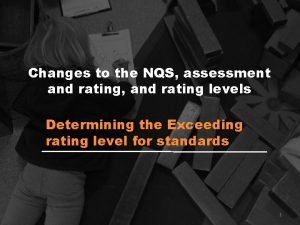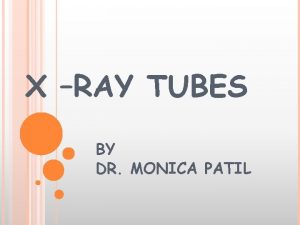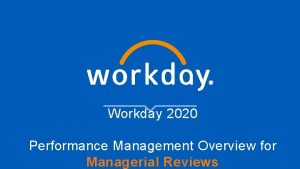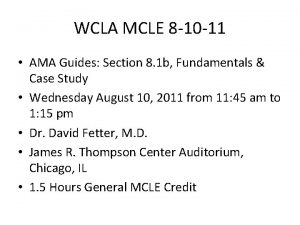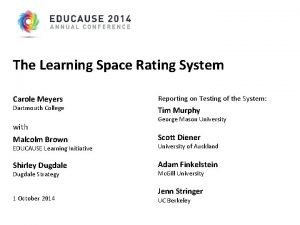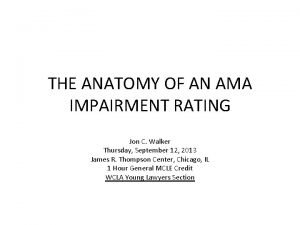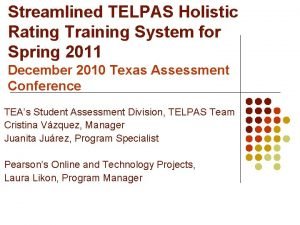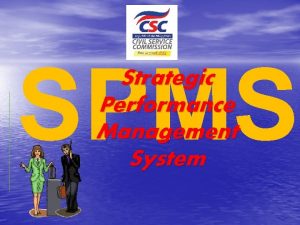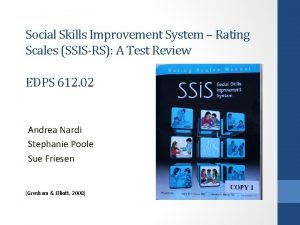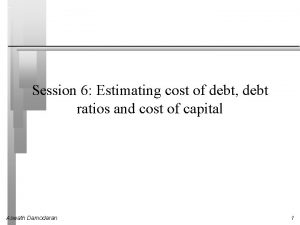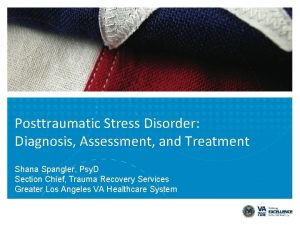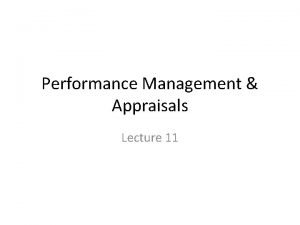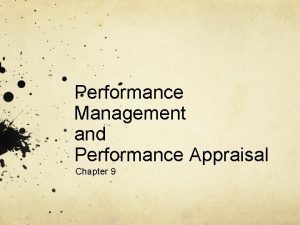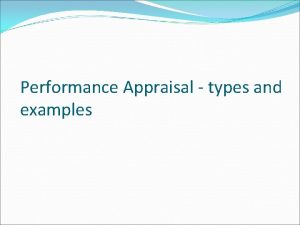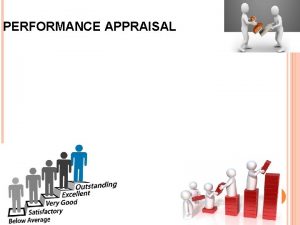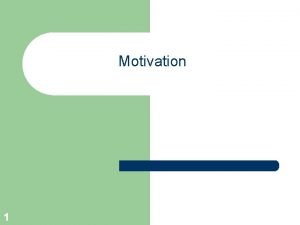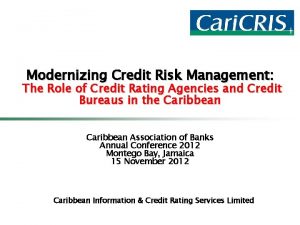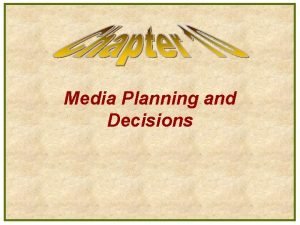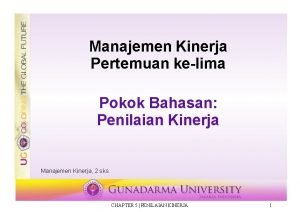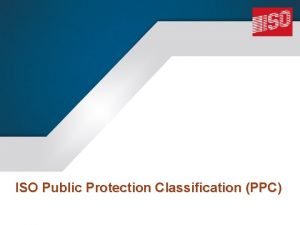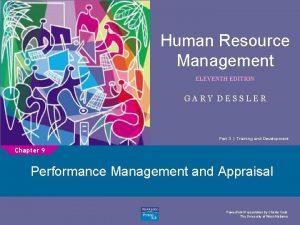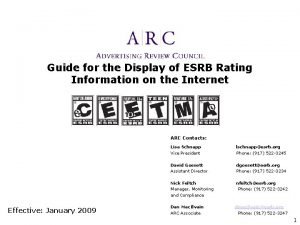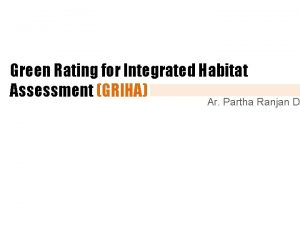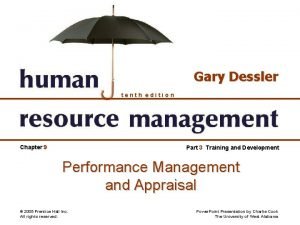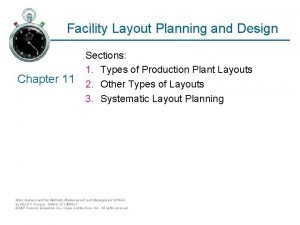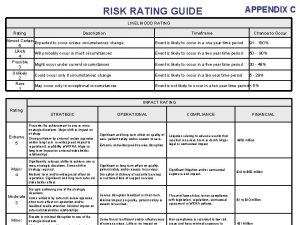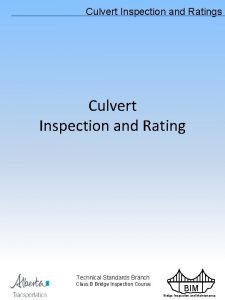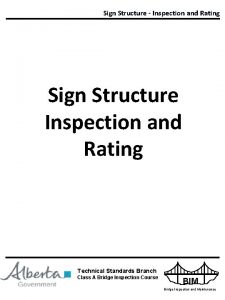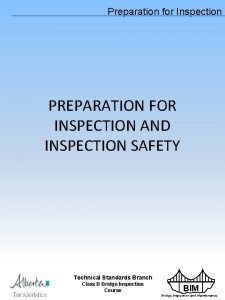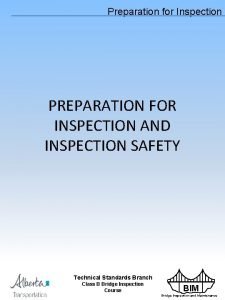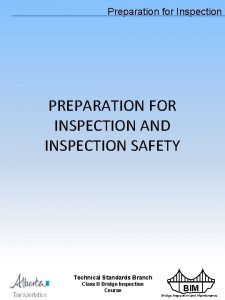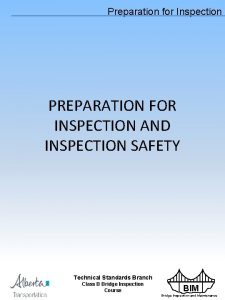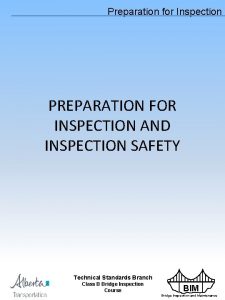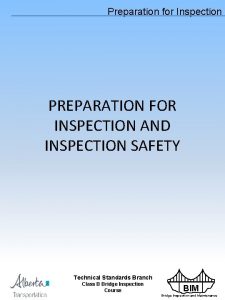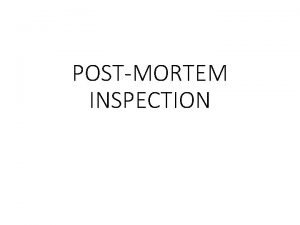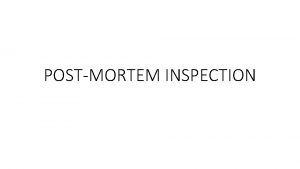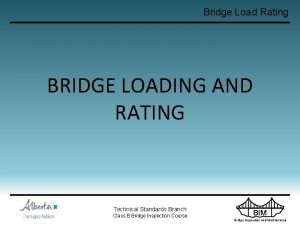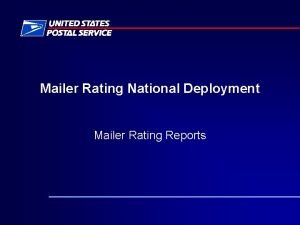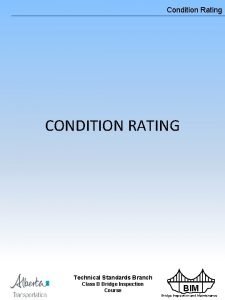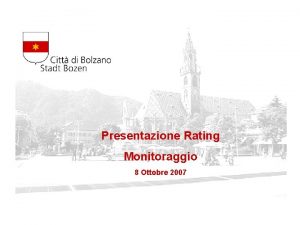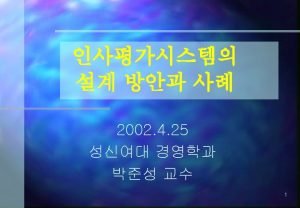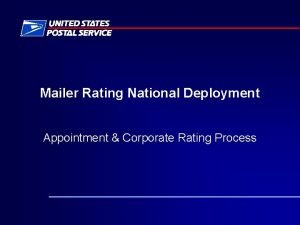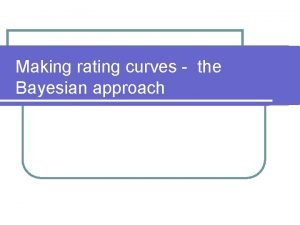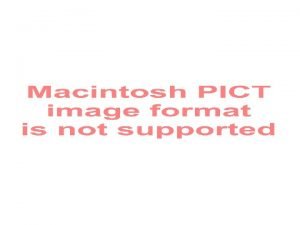Major Superstructure Inspection and Rating Major Superstructure Inspection






















































- Slides: 54

Major Superstructure – Inspection and Rating Major Superstructure Inspection and Rating Technical Standards Branch Class A Bridge Inspection Course 1

Major Superstructure – Inspection and Rating Wearing Surface • • Bonded or fastened to the deck In direct contact with the traffic Not part of the “structural” deck Purpose Ø Protects the bridge deck • traffic wear • salt and water infiltration Ø Provides a smooth wearing surface Ø Provides skid resistance Technical Standards Branch Class A Bridge Inspection Course 2

Major Superstructure – Inspection and Rating Wearing Surface • Types Ø Asphalt Ø Timber • untreated • treated Ø Polymer membranes Ø Concrete overlay • silica fume • high density • latex modified • other (Pyrament) • fibre reinforced Ø May have more than one type • i. e. polymer membrane on concrete overlay Technical Standards Branch Class A Bridge Inspection Course 3

Major Superstructure – Inspection and Rating Wearing Surface • Drive over deck at design or posted speed • Observe traffic crossing bridge Ø Look for deflections or movement Ø Listen for unusual noises • Look for defects common to the material • Look for debonding, loosening or loss of wearing surface Ø Sound for debonding using hammer if suspected • Look for protruding nails in timber wearing surfaces • Look for loss of aggregate from polymer wearing surfaces or seal coats • Look for polishing of concrete overlays especially high density Technical Standards Branch Class A Bridge Inspection Course 4

Major Superstructure – Inspection and Rating Wearing Surface • TT, TH and PT forms PCS and PSR only • PCS, PSR, SG, SS, DT and CON forms Technical Standards Branch Class A Bridge Inspection Course 5

Major Superstructure – Inspection and Rating Wearing Surface • Record or verify type • Record or verify Ø Thickness Ø Size (TH & PT only) • Record or verify the presence of Lateral Connection Problem (Y/N) Ø PSR and PCS only Ø Rate under girders • If no wearing surface, rating is for Deck Top Ø TH, PT and TT only Technical Standards Branch Class A Bridge Inspection Course 6

Major Superstructure – Inspection and Rating Wearing Surface • Record in Explanation of Condition location, severity and extent of Ø Wear Ø Scaling / raveling Ø Cracks Ø Debonding Ø Wearing surface loss Technical Standards Branch Class A Bridge Inspection Course 7

Major Superstructure – Inspection and Rating Wearing Surface • Rate according to existing condition and functionality • If wearing surface does not have sufficient skid resistance Ø rate 4 or less • If wearing surface does not cover the entire deck (curb to curb) Ø rate 4 or less Ø rate 2 if traffic hazard • Exposed nails or other fasteners Ø rate 4 or less • If speed has to be reduced due to potholes, missing planks, ruts or other deterioration Ø rate 3 Technical Standards Branch Class A Bridge Inspection Course 8

Major Superstructure – Inspection and Rating Wearing Surface Concrete Overlay Rating Guide • Crack definitions – Hairlines <0. 1 mm – Narrow>0. 1 mm and <0. 3 mm – Medium >0. 3 mm and <1. 0 mm – Wide >1. 0 mm Technical Standards Branch Class A Bridge Inspection Course 9

Major Superstructure – Inspection and Rating Wearing Surface Asphalt Pavement Condition Severity Guide Technical Standards Branch Class A Bridge Inspection Course 10

Major Superstructure – Inspection and Rating Wearing Surface Asphalt Pavement Condition Severity Guide (Part 2) Technical Standards Branch Class A Bridge Inspection Course 11

Major Superstructure – Inspection and Rating Wearing Surface Rating Guide - ACP Technical Standards Branch Class A Bridge Inspection Course 12

Major Superstructure – Inspection and Rating Wearing Surface Rating Guide Polymer / Seal Coat Technical Standards Branch Class A Bridge Inspection Course 13

Major Superstructure – Inspection and Rating Deck Drainage • • • Not included on TT, PT or TH forms Poor drainage Ø Common cause of deck deterioration Ø May cause a hazard due to hydroplaning or icing Ø Caused by inadequate design, construction or maintenance practices Ø May affect other bridge elements § superstructure § substructure § headslopes and sideslopes Drainage system includes Ø gutters, inlet boxes, scuppers, downpipes and catch basins Ø drainage problems at deck joints § sealed § with plumbing § non-watertight Technical Standards Branch Class A Bridge Inspection Course 14

Major Superstructure – Inspection and Rating Deck Drainage Deck Drain Technical Standards Branch Class A Bridge Inspection Course 15

Major Superstructure – Inspection and Rating Deck Drainage Technical Standards Branch Class A Bridge Inspection Course 16

Major Superstructure – Inspection and Rating Deck Drainage • Check for: Ø plugging of inlet boxes, scuppers, downpipes and joint plumbing Ø corrosion of metal components Ø gouges, cracks, breaks or tears § joint seals Ø integrity of attachments and connections § loose or missing bolts § cracked or broken welds § loose or open connections Ø length of downpipes Technical Standards Branch Class A Bridge Inspection Course 17

Major Superstructure – Inspection and Rating Deck Drainage • Check for: Ø signs of ponding on the deck Ø damage to the deck, curbs, girders and substructure § staining (water and rebar corrosion) § scaling § freeze-thaw § delaminations § spalling Ø erosion below downpipe Technical Standards Branch Class A Bridge Inspection Course 18

Major Superstructure – Inspection and Rating Deck Drainage • Record or verify if drains or joint plumbing is clogged Technical Standards Branch Class A Bridge Inspection Course 19

Major Superstructure – Inspection and Rating Deck Drainage • For timber decks or steel grating Ø not on TT, TH & PT forms • water ponded on the deck rate 4 or less • water ponding is a hazard rate 2 • drains leak or downpipes too short rate 4 or less • ponding, leakage or discharge causes significant deterioration of deck, curbs, girders or substructure rate 3 or less • erosion on sideslopes or headslopes from discharge rate 4 or less • Deck joint leakage causing damage - reduce rating Technical Standards Branch Class A Bridge Inspection Course 20

Major Superstructure – Inspection and Rating Deck Top/Underside • • Purpose Ø Carries traffic loads Ø Transfers loads to main structural members Ø Can be in direct contact with traffic in the absence of a wearing surface Types Ø Cast in place concrete Ø Precast concrete Ø Timber Ø Steel grate Separate ratings for top and underside Ø Except for PCS, rate underside with top and girders May not be inspectable from the top Ø Wearing surface Ø Snow, ice or gravel Technical Standards Branch Class A Bridge Inspection Course 21

Major Superstructure – Inspection and Rating Deck Top/Underside • Drive over deck at design or posted speed • Observe deck under traffic Ø Listen for unusual noises Ø Look for deflections or movement • Look over deck top and underside for problems with material • On concrete decks, sound suspect areas with a hammer to detect delaminations Ø Birdbath locations Ø Stained areas Ø Badly cracked areas or adjacent to large cracks Technical Standards Branch Class A Bridge Inspection Course 22

Major Superstructure – Inspection and Rating Deck Top/Underside • Deck Top rated separately except for PT, TH and TT where Wearing Surface / Deck Top combined • Applies to PT, TH and TT only Applies to DT and SS only • Remainder applies to SG, PSR, CON, DT and SS Technical Standards Branch Class A Bridge Inspection Course 23

Major Superstructure – Inspection and Rating Deck Top/Underside • Record or verify subdeck type and size for TH, PT& TT • Record or verify deck underside Ø % defects for TH, PT & TT Ø % stains for all others • Record if snow slots filled for DT & SS • Record location, severity and extent of Ø Staining Ø Scaling Ø Cracks Ø Delaminations Ø Spalling Technical Standards Branch Class A Bridge Inspection Course 24

Major Superstructure – Inspection and Rating Deck Top/Underside • Rate according to existing condition and functionality • Speed reduced due to deterioration Ø rate 4 or less • Surface does not have sufficient skid resistance Ø rate 4 or less • Steel grating Ø connections are loose or broken rate 4 or less Ø improper bearing or support on girders rate 4 or less • Timber Ø minor splitting in non-adjacent planks - rate 5 or more Ø any rot - rate 4 or less Ø broken planks - rate 4 or less Ø connections loose or broken - rate 4 or less Technical Standards Branch Class A Bridge Inspection Course 25

Major Superstructure – Inspection and Rating Deck Underside Concrete Deck Rating Guide • Crack definitions Ø Hairline <0. 1 mm Ø Narrow >0. 1 mm and <0. 3 mm Ø Medium >0. 3 mm and <1. 0 mm Ø Wide >1. 0 mm Technical Standards Branch Class A Bridge Inspection Course 26

Major Superstructure – Inspection and Rating Deck Underside Concrete Staining Deck Rating Guide Technical Standards Branch Class A Bridge Inspection Course 27

Major Superstructure – Inspection and Rating Concrete Girders • Purpose Ø Receive the loads from the deck Ø Transmit the loads to the substructure (through the bearings) • Three types Ø Cast-in-place standard reinforced Ø Standard reinforced precast Ø Prestressed or post-tensioned precast Technical Standards Branch Class A Bridge Inspection Course 28

Major Superstructure – Inspection and Rating Concrete Girders • Inspection is primarily visual, looking for Ø Staining Ø Scaling Ø Cracks Ø Delaminations Ø Spalling • Observe girders under traffic and look for unusual deflections or movement Ø Independent movement on laterally connected girders • Evidence of grout key or lateral connection failure Ø Cracking or loss of grout in grout key Ø Cracking in pavement Ø Corrosion, or missing, loose or broken bolts at channel connectors Ø staining on underside of keys Technical Standards Branch Class A Bridge Inspection Course 29

Major Superstructure – Inspection and Rating Concrete Girders • Grout key failure Technical Standards Branch Class A Bridge Inspection Course 30

Major Superstructure – Inspection and Rating Concrete Girders • On post-tensioned girders check end anchorage zones • Check for corrosion of prestressing or post-tensioning cables Ø rust stains or cracking along sides of girders Ø leakage onto ends of girders with staining from ends of cables • Cracking in end anchorage zone of prestressed girders • High load damage which breaks the concrete around the pre- or post-stressed cables Ø Look for damaged or broken cables Technical Standards Branch Class A Bridge Inspection Course 31

Major Superstructure – Inspection and Rating Concrete Girders • Record or verify the presence of cracking Ø PCS, PSR & CON Ø Not hairline/narrow flexural on PCS or CON • Record or verify the amount of spalling in % Ø PCS and PSR Ø Corrosion induced spalling on bottoms and sides over stirrups only Ø % of total leg or girder length • Girder Detail Ratings on PCS forms only Technical Standards Branch Class A Bridge Inspection Course 32

Major Superstructure – Inspection and Rating Concrete Girders • Record in Explanation of Condition location, severity and extent of Ø Staining Ø Scaling Ø Cracks Ø Delaminations Ø Spalling Ø Grout Key failure Technical Standards Branch Class A Bridge Inspection Course 33

Major Superstructure – Inspection and Rating Reinforced Concrete Girder Rating • Applies to all plain reinforced concrete girders Ø Not prestressed or post-tensioned • If curb girder only affected, can increase ratings by one Ø Has lower load carrying function Ø Does not apply to shear cracks Technical Standards Branch Class A Bridge Inspection Course 34

Major Superstructure – Inspection and Rating Reinforced Concrete Girder Rating Spalling or Longitudinal Cracking on Bottom of Legs RATING DESCRIPTION 5 Medium crack & sound concrete - anchor zone Wide crack/spall - other zones 4 Medium crack - anchor zone Wide crack/spall sound concrete - other zones 4 Moderate section loss on main bars or stirrup bends up to 10% 3 Wide cracks or spall with sound concrete - anchor zone 2 Spall with unsound concrete - anchor zone 2 Severe loss of section on main bars or stirrup bends greater than 20% *Increase rating one point for: -PG and PA girders OR cracking limited to one leg -Defects limited to curb girder only Technical Standards Branch Class A Bridge Inspection Course 35

Major Superstructure – Inspection and Rating Reinforced Concrete Girder Rating Shear Cracks *Must be 60 degrees or less from horizontal RATING 5 3 2 DESCRIPTION Narrow* Medium* Wide or growing* *Reduce by one if wide longitudinal crack or spall in anchorage zone Technical Standards Branch Class A Bridge Inspection Course 36

Major Superstructure – Inspection and Rating Reinforced Concrete Girder Rating Other Defects RATING DESCRIPTION No effect Hairline or narrow flexural cracks 6 End diaphragm spall Narrow map cracks 5 Top slab transverse crack 4 Medium or wide map cracking or any map cracking with staining 4 Medium flex or narrow grout key cracks Technical Standards Branch Class A Bridge Inspection Course 37

Major Superstructure – Inspection and Rating Reinforced Concrete Girder Rating Other Defects RATING 4 3 3 3 2 2 DESCRIPTION Small (150 mm max) punchouts Medium or wide grout key cracks Other punchouts Failed girder connectors Wide flexural cracks End diaphragm spall extending into legs Technical Standards Branch Class A Bridge Inspection Course 38

Major Superstructure – Inspection and Rating Reinforced Concrete Girder Rating Typical Defects Technical Standards Branch Class A Bridge Inspection Course 39

Major Superstructure – Inspection and Rating Prestressed Concrete Girder Rating • Applies to all prestressed and posttensioned concrete girders • Reduce as needed to reflect condition & function • If curb girder only affected, can increase ratings by one Ø Has lower load carrying function Ø Does not apply to shear cracks Technical Standards Branch Class A Bridge Inspection Course 40

Major Superstructure – Inspection and Rating Prestressed Concrete Girder Rating RATING 4 3 3 2 DESCRIPTION Hairline cracks* All other cracks* Corrosion stains from strands Cracks with corrosion in webs, flanges or bottom of boxes 2 Any cracks that are growing 1 Cracks opening and closing or with slippage *Some cracks are acceptable and don’t affect rating Technical Standards Branch Class A Bridge Inspection Course 41

Major Superstructure – Inspection and Rating Prestressed Concrete Girder Rating • • Chamfer crack at girder ends: Longitudinal crack in bottom half of leg at girder ends: Longitudinal crack underside of leg: Diagonal crack in web transition: Technical Standards Branch Class A Bridge Inspection Course 42 N=5, M/W=4 H/N= 5 M/W=4 H/N=5, M/W=4 =5

Major Superstructure – Inspection and Rating Prestressed Concrete Girder Rating DBT Girders Crack in girder end block through transition zone • Diagonal crack in end block area - rate 5 Ø Not extending into bottom 1/4 of girder Ø No staining Ø Reduce by 1 if into flange or thin web section Technical Standards Branch Class A Bridge Inspection Course 43

Major Superstructure – Inspection and Rating Prestressed Concrete Girder Rating SM, VS, SC, RD, RM, PM, VM Girders • • Longitudinal crack on underside- rate 5 Longitudinal crack curb fascia- rate 5 Crack in fascia at pier connection- rate 5 Bottom diagonal crack in ends - rate 5 Ø Not longer than 0. 5 m from cap or seat Ø No corrosion staining Ø With corrosion staining- rate 3 Technical Standards Branch Class A Bridge Inspection Course 44

Major Superstructure – Inspection and Rating Diaphragms / Cross Frame • Purpose Ø Distribute loads between girders Ø Resist torsion forces Ø Support the compression flange of the girder • Generally made out of the same material as the girder Ø If not, usually steel • Rate according to condition and ability to function as designed • If diaphragms contribute to defects in the girder - rate 4 or less Technical Standards Branch Class A Bridge Inspection Course 45

Major Superstructure – Inspection and Rating Steel Girder • • • Purpose Ø Receive loads from the deck Ø Transmit loads to the substructure Two types Ø Rolled beam Ø Welded plate girders Usually I-shaped Ø Web Ø Flanges Each part of girder rated separately Stiffeners Ø Vertical at bearings & along span Ø Horizontal in high bending stress areas Cover plates Ø Extra plates welded to flanges to increase capacity in high bending areas Technical Standards Branch Class A Bridge Inspection Course 46

Major Superstructure – Inspection and Rating Steel Girder • Cracks Ø Tension areas Ø End of cover plates Ø Stiffeners welded to bottom flange Ø Re-entrant corners Ø Changes in section Ø Stiffener welds that cross the weld from flange to web Ø Gouges, nicks, holes, collision damage • Buckling Ø High stress areas such as at bearings Technical Standards Branch Class A Bridge Inspection Course 47

Major Superstructure – Inspection and Rating Steel Girder • • Alignment Ø Twists, bows, bends, sags Corrosion Ø Top of bottom flange Ø Around connections Ø Under joints Connections Ø Loose or missing bolt or rivets Ø Poorly fitted connections Ø Misaligned bolt holes Ø Deformed bolt holes Ø Corrosion between plates • warping of plates Collision damage Ø Grade separations Technical Standards Branch Class A Bridge Inspection Course 48

Major Superstructure – Inspection and Rating Steel Girder • Notches or stress raisers in tension areas Ø rate 4 • If corrosion is causing a loss of section Ø rate 4 or less • If any signs of distortion or misalignment Ø rate 4 or less • If fatigue cracks or signs of distortion Ø rate 4 or less • Elements with visible cracks Ø rate 3 or less • Fatigue cracks in bottom flange extending into web Ø rate 2 or less Technical Standards Branch Class A Bridge Inspection Course 49

Major Superstructure – Inspection and Rating Steel Truss Members • Purpose of truss as a unit is to: Ø Receive loads from deck Ø Transmit loads to substructure (through bearings) • Three types of trusses Ø Through Ø Pony Ø Deck • Member types are rated separately • Includes stringers and floor beams • Truss members in tension or compression Ø Inspector must identify each Ø Different concerns Technical Standards Branch Class A Bridge Inspection Course 50

Major Superstructure – Inspection and Rating Steel Truss Members • Check alignment of trusses Ø top chord alignment especially important because it is in compression • Check for wide or high load damage Ø If any present, indicate “YES” and explain in Explanation of Condition Ø Especially look at portal bracing and sway bracing Ø Wide or high load damage will affect the rating of the member(s) damaged • compression members rating are especially lowered by bends • tension members by cracks or nicks Ø Check connections and members adjacent to damaged member Technical Standards Branch Class A Bridge Inspection Course 51

Major Superstructure – Inspection and Rating Steel Truss Members • Check each truss member in an orderly fashion Ø On tension members or collision damaged members look for cracks at connections • crack will most often be at first bolt hole on the member side • light members with significant stress or stress reversal Ø On compression members look for kinks or bows Ø Look for welds or torch cuts • crack prone Ø Look for fatigue prone details • sharp radius corners • notches • light members - especially with stress reversal Ø Check which members govern load capacity • Allowable Load on first page of form Technical Standards Branch Class A Bridge Inspection Course 52

Major Superstructure – Inspection and Rating Steel Truss Members • Check each connection in an orderly fashion Ø Loose or missing bolt or rivets Ø poorly fitted connections Ø misaligned bolt holes Ø deformed bolt holes Ø corrosion between plates • warping of plates • Check for Corrosion Ø Between Built up members Ø Splash zone Ø bottom chord, especially channel section Technical Standards Branch Class A Bridge Inspection Course 53

Major Superstructure – Inspection and Rating Steel Truss Members • Corrosion causing a loss of section Ø rate 4 or less • Distortion or misalignment on a tension member, no other defects - rate 5 • Minor misalignment or damage to cross-bracing or portal - rate 5 • Cracks in a tension member - rate 3 or less • Cracks in a compression member - rate 4 or less • Any fatigue cracks - rate 4 or less Ø Cracks on bottom flange of floor beam or stringer extending into web - rate 2 or less Technical Standards Branch Class A Bridge Inspection Course 54
 Riset rating dan non rating
Riset rating dan non rating Spcsp culvert
Spcsp culvert Base and superstructure in marxism
Base and superstructure in marxism Substructure and superstructure in bridges
Substructure and superstructure in bridges Well foundation
Well foundation Superstructure sociology
Superstructure sociology Marx base and superstructure
Marx base and superstructure Communism
Communism Superstructure sociology
Superstructure sociology Superstructure walls
Superstructure walls Superstructure
Superstructure Categorical plan vendor rating
Categorical plan vendor rating Rating billing
Rating billing Rating scales and rubrics
Rating scales and rubrics Pilot testing in performance management
Pilot testing in performance management Nqs assessment
Nqs assessment Emotional rating scale
Emotional rating scale Grid controlled x ray tube
Grid controlled x ray tube Sil rating table
Sil rating table Workday rating scale
Workday rating scale Ama impairment rating chart
Ama impairment rating chart Vbi interview questions
Vbi interview questions Performance rating scale examples
Performance rating scale examples Learning space rating system
Learning space rating system Ama impairment rating chart
Ama impairment rating chart Supports intensity scale rating key
Supports intensity scale rating key Texas assessment.gov/telpastrainingcenter
Texas assessment.gov/telpastrainingcenter How to make ipcr
How to make ipcr Social skills improvement system scoring
Social skills improvement system scoring Rumus rating scale
Rumus rating scale Ska assessment
Ska assessment Interest coverage ratio damodaran
Interest coverage ratio damodaran Heathrow elementary school
Heathrow elementary school Predictive vulnerability
Predictive vulnerability Va ptsd rating scale pdf
Va ptsd rating scale pdf Potential appraisal
Potential appraisal Graphic rating scale
Graphic rating scale Unclear standards in performance appraisal
Unclear standards in performance appraisal Field review method example
Field review method example Define performance appraisal
Define performance appraisal Pcit therapy
Pcit therapy Behaviorally anchored rating scale
Behaviorally anchored rating scale Credit rating scale
Credit rating scale Gross rating points
Gross rating points Meeting performance
Meeting performance Latent aspect rating analysis
Latent aspect rating analysis Latent aspect rating analysis
Latent aspect rating analysis Jenis skala psikologi
Jenis skala psikologi Fire suppression rating schedule
Fire suppression rating schedule Example of semantic differential scale in affective domain
Example of semantic differential scale in affective domain Graphic rating scale method
Graphic rating scale method Esrb arc manual
Esrb arc manual Which rating star is given by griha for points 71-80
Which rating star is given by griha for points 71-80 Graphic rating scale method
Graphic rating scale method Layout planning and design
Layout planning and design

